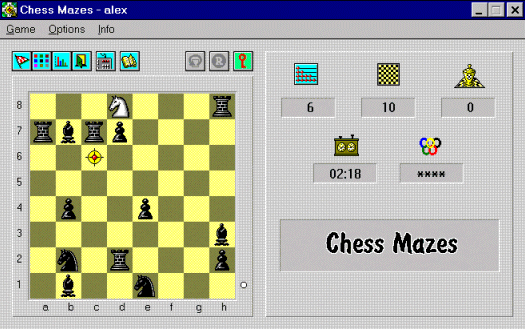Chess Mazes
by Aleksey Bartashnikov
Chess Mazes is a computer game. Below, you see a description of the game.
Aim of the Game
By its nature the game resembles a maze through which the optimum way has to be found as quickly as possible. But the maze is not presented graphically, its air-castle walls being shaped by squares guarded by enemy pieces. Your task is to transfer your single piece from the square it occupies in the initial position to a target square designated by a special symbol. But you have to do it without getting assailed by pieces of the other side (the PC). You are to choose the colour of your piece and, accordingly, the opponents pieces . Making moves on the board is also up to you alone. The PCs pieces just stand there motionlessly waiting for their moment to come... But when your piece has carelessly stepped on a square aimed at by a unit of the opponent the program will immediately capture it, and that will mean you have lost. But if you manage to reach the desired square within the allotted time interval and in no more than 70 moves, the victory is yours. As soon as you hit the target, place your piece on a losing square, or exceed the limit of moves, the program displays an appropriate message on the screen one of congratulation or sympathy. Along with this message you will be informed about the distance you have covered and the length of the shortest possible route. Both routes - yours and the theoretically shortest one - will be demonstrated on the chessboard by means of a curved line with dots on the squares your piece stepped on/should have stepped on. In case you do not enter your answer in time, if you exceed the time limit, the program will act in an analogous way.
There may be several solutions to a task, i.e. several routes leading to the target square through the maze. On order to win you only need to demonstrate any one of them. However, the number of points you get for your victory (when you lose you score no points) will depend on how close the route you have proposed is to the optimum one: if you have discovered the shortest route you get the most points. Therefore do not try to capture all of the opponents pieces hastily. If an enemy unit is unprotected then you can naturally eliminate it. But that will probably make your route much longer than the optimum one.
Here is an example of the game (6th level of dificulty). Try to solve it!

What is the best route to transfer your white knight from d8 to c6? Finding the shortest path will not suffice; in addition, the pieces journey has to be safe. Indeed, the enemy men stay awake... Small hint: the shortest route - 23 moves!
More detail description of the game and a place to download an evaluation copy of the program you will find at the Chess Puzzles Series.
Written by Aleksey Bartashnikov. HTML conversion by David Howe.
WWW page created: May 27, 1998. Last modified: December 14, 2001.